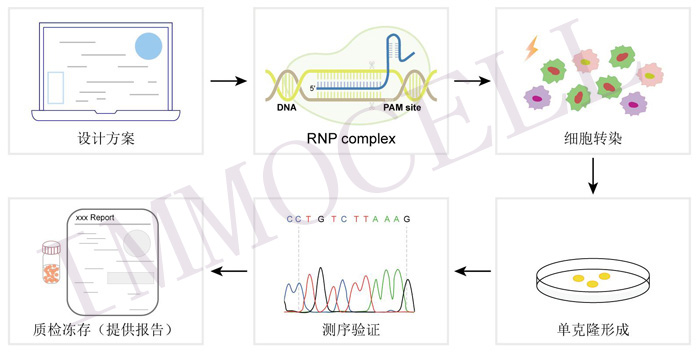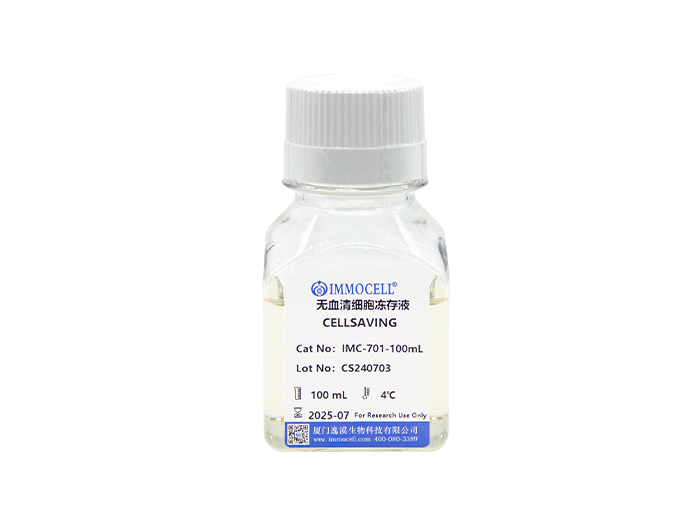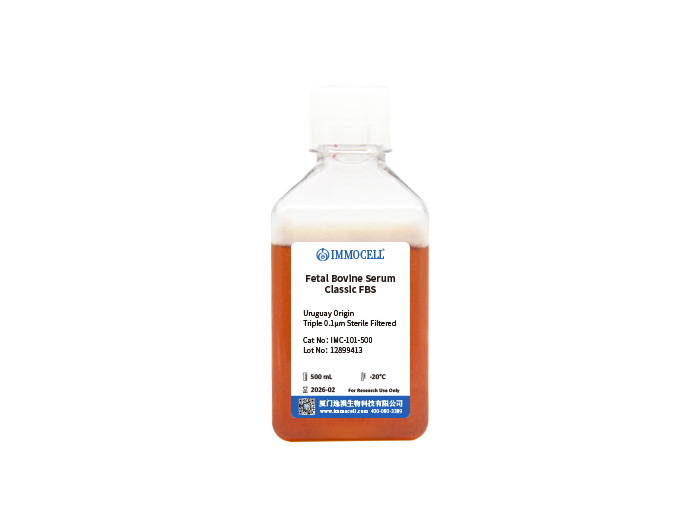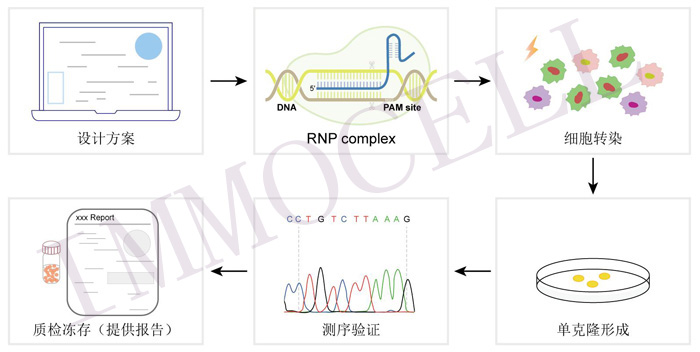| 一、细胞基本属性 | |||||
| 产品名称 | PSMD4 knockout HeLa cell line | ||||
| 产品货号 | IMKO-H013 | ||||
| 产品规格 | 1×106cells/T25或1mL冻存管 | ||||
| 储存及运输 | 干冰运输;储存在液氮中 | ||||
| 产品分类 | Hela细胞 | ||||
| 物种 | 人 | ||||
| 修饰基因 | PSMD4 | ||||
| 修饰类型 | 基因敲除 | ||||
| 转导方法 | CRISPR/Cas9 | ||||
| 克隆类型 | 纯化克隆 | ||||
| 细胞鉴定 | 通过遗传学方法确认PSMD4基因敲除 | ||||
| 细胞形态 | 上皮细胞样 | ||||
| 生长特性 | 贴壁生长 | ||||
| 培养体系 | 90%MEM+10% FBS+1%PS | ||||
| 传代比例 | 1:2至1:3 | ||||
| 传代周期 | 每周3次 | ||||
| 培养条件 | 气相:95%空气+5%二氧化碳;温度:37℃ | ||||
| 冻存条件 | 无血清冻存液,液氮储存 | ||||
补充内容 | PSMD4在多种实体肿瘤中上调,包括肝细胞癌(HCC),其存在与细胞增殖、Akt/GSK-3β/环氧化酶2(COX2)途径的激活、抑制p53启动子活性以及p53降解增加等因素有关。PSMD4通过Akt/COX2途径和p53抑制推动肝细胞癌的进展。PSMD4通过蛋白水解途径中的泛素介导和蛋白酶体介导蛋白降解,促进细胞增殖,与肝细胞癌的发展密切相关。 研究发现,PSMD4过度表达在HCC组织和细胞系中确定,通过Northern blot、Western blot和免疫组化技术。沉默PSMD4可阻止细胞增殖和肿瘤生长,诱导细胞凋亡。进一步的研究表明,PSMD4的阻断能够抑制肝细胞癌的发生。 | ||||
| 构建方法 |  | ||||
| PSMD4基因敲除细胞系的构建通常涉及的步骤 | 1.选择合适的靶向PSMD4基因的sgRNA序列,通常利用在线工具设计合适的sgRNA序列。 2.合成设计好的sgRNA序列,通常通过化学合成来制备。 3.将合成的sgRNA和Cas9蛋白转染入目标细胞内,使其形成编辑复合物。 4.使用适当的筛选方法(如阳性筛选标记物)筛选出成功编辑的细胞。 5.对成功编辑的细胞进行单克隆化,并验证PSMD4基因的敲除效果,通常通过PCR、Western blot等方法进行验证。 6. 对PSMD4敲除细胞系进行功能验证,如观察细胞增殖、凋亡等生物学特征的变化,评估PSMD4基因敲除对细胞功能的影响。 | ||||
| PSMD4基因的基本信息 | Species | Gene Symbol | Gene ID | GenBank Accession | Transcript |
Human (Homo sapiens) | PSMD4 | 5710 | NM_001330692.2 | NP_001317621.1 | |
| 关于基因 | Official Symbol | PSMD4 | |||
| Previous Symbol | PSMD4 | ||||
| Official Full Name | Proteasome 26S subunit ubiquitin receptor, non-ATPase 4 | ||||
| Synonyms | Rpn10, S5A, AF, AF-1 | ||||
| Location | 1q21.3 | ||||
| Gene Type | Protein Coding | ||||
| Uniprot ID | Q5VWC4 | ||||
| Pathway/Library | Regulation of activated PAK-2p34 by proteasome mediated degradation, Assembly of the pre-replicative complex | ||||
| Gene Summary | The 26S proteasome is a multicatalytic proteinase complex with a highly ordered structure composed of 2 complexes, a 20S core and a 19S regulator. The 20S core is composed of 4 rings of 28 non-identical subunits; 2 rings are composed of 7 alpha subunits and 2 rings are composed of 7 beta subunits. The 19S regulator is composed of a base, which contains 6 ATPase subunits and 2 non-ATPase subunits, and a lid, which contains up to 10 non-ATPase subunits. Proteasomes are distributed throughout eukaryotic cells at a high concentration and cleave peptides in an ATP/ubiquitin-dependent process in a non-lysosomal pathway. An essential function of a modified proteasome, the immunoproteasome, is the processing of class I MHC peptides. This gene encodes one of the non-ATPase subunits of the 19S regulator lid. Pseudogenes have been identified on chromosomes 10 and 21. [provided by RefSeq, Jul 2008] | ||||
相关问题
培养指南
-
hiPSC人诱导多能干细胞培养教程:在培养hiPSC细胞前,需准备好hESC/iPSC完全培养基配制和Matrigel铺板,hiPSC人诱导多能干细胞复苏操作,1. 将水浴锅预热至37℃;并将Matrigel包被的6孔板,提前放置生物安全柜中约1小时恢复···...
阅读详情 -
H9人胚胎干细胞培养条件与方法:1. 将水浴锅预热至37℃,并将Matrigel包被的6孔板,提前放置生物安全柜中约1小时恢复至室温(15~30℃);2. 取4 mL hESC/iPSC完全培养基,按照1:4000比例加入1 μL的hESC/iPSC Supplement C,···...
阅读详情 -
H1人胚胎干细胞培养指南:在培养h1干细胞之前,首先要准备好hESC/iPSC完全培养基配制, 铺板,H1人胚胎干细胞复苏步骤:1.将水浴锅预热至37℃;并将Matrigel包被的6孔板,提前放置生物安全柜中约1小时恢复至室温(15~30℃);···...
阅读详情 -
4T1细胞培养方法:小鼠乳腺癌4T1细胞培养基 90%DMEM+10% FBS+PS,生长条件:气相:95%空气+5%二氧化碳;温度:37℃,4T1细胞形态特征为上皮细胞样,贴壁生长,如果4T1细胞密度达80%-90%,即可进行传代培养,传代方法:1:2至1:3···...
阅读详情 -
常用人肝癌细胞系有哪些及如何选择:目前较为常用的几株人肝癌细胞系SMMC-7721、Bel-7402、MHCC97、HepG2、Hep3B、Huh-7 and PLC/PRF/5,那么人肝癌细胞株如何选择呢?一方面你可以查找相关的文献,另一方面可以考虑选择···...
阅读详情 -
HL-60细胞生长慢解决方法及如何养好:当HL-60细胞传代后生长速度慢且状态不佳时,可竖着培养直到培养基变黄,待细胞密度起来后,状态会有所好转,同时,若HL-60细胞状态很差,可采用半换液的方式:以T25瓶子为例,瓶子里有5m···...
阅读详情






















